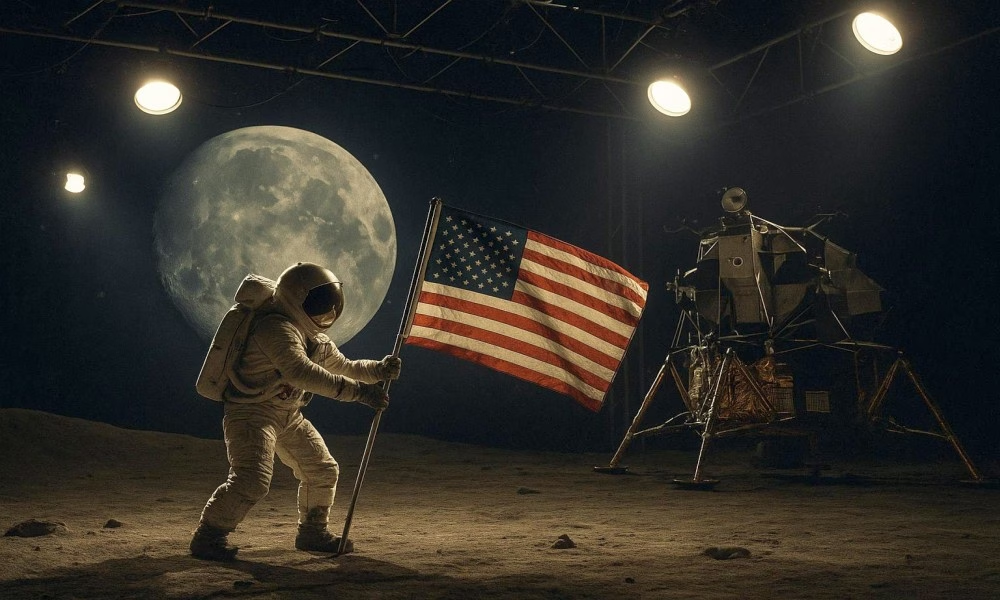
In July 1969, NASA’s Apollo 11 mission successfully landed humans on the Moon, fulfilling President Kennedy’s daring goal and cementing America’s dominance in the Space Race.
Or… did it?
According to the Moon Landing Hoax Theory, the entire event — from Neil Armstrong’s first step to the famous American flag planting — was an elaborate fabrication, staged on Earth (possibly in a secret Hollywood set, or even with the help of legendary director Stanley Kubrick).
Proponents of the theory claim that the U.S. government faked the landings to score a Cold War victory over the Soviet Union, boost national morale, and avoid the humiliation of failure after spending billions of dollars.
The Moon landing hoax theory didn’t take long to surface. In fact, doubts began almost as soon as the first grainy black-and-white footage aired. In 1974, author Bill Kaysing published “We Never Went to the Moon: America’s Thirty Billion Dollar Swindle,” often considered the founding text of the Moon hoax movement. Kaysing, a former employee at a company that worked with NASA, had no background in spaceflight or engineering — but he knew a juicy conspiracy when he saw one.
Throughout the 1970s and beyond, skeptics pointed to supposed “anomalies” in photos and videos from the missions: strange shadows, waving flags, missing stars, suspicious lighting, and other “evidence” that, they claimed, pointed to a giant fraud.
The hoax theory gained even more steam in the post-Watergate era, when distrust of government was practically an American pastime.
Despite mountains of evidence, technical explanations, and the testimony of thousands of scientists and engineers, the Moon landing hoax theory stubbornly persists.
Polls in the 1990s suggested that around 6% to 20% of Americans harbored doubts about the Moon landings. Globally, skepticism is even higher: in Russia, for example, a 2018 survey found 57% believed the landings were faked.
In the internet age, the theory found new life. YouTube videos, documentaries, and internet forums have kept the conspiracy alive, often lumping it in with broader “everything is fake” worldviews.
While it’s tempting to laugh it off as harmless, widespread distrust of major institutions — including science and government — can have real-world consequences. Moon hoax theories are part of a larger trend of conspiratorial thinking that affects public trust in everything from vaccines to climate science.
Important Facts, Figures, and Characters
- Bill Kaysing (1922–2005): The “godfather” of Moon landing denial. His book sparked decades of skepticism despite being based largely on speculation rather than evidence.
- Bart Sibrel: A modern Moon hoax advocate known for ambushing Apollo astronauts to accuse them of lying. Famously, astronaut Buzz Aldrin, then 72 years old, punched Sibrel in the face during one such encounter in 2002. (Aldrin was not charged — public opinion cheered him on.)
- Stanley Kubrick Theory: Some conspiracists claim director Stanley Kubrick helped fake the Moon landings because of the technical mastery he demonstrated in 2001: A Space Odyssey. This theory even inspired the darkly funny documentary Room 237, which explores wild theories about Kubrick’s work.
- NASA’s Counterarguments: Scientists have pointed out that:
- Reflectors placed on the Moon during Apollo missions are still bouncing lasers back to Earth today.
- Thousands of photos, telemetry data, and Moon rocks (which independent scientists worldwide have verified) back up the missions.
- Tracking stations around the world, including ones not controlled by the U.S., monitored Apollo’s journey.
- Third Party Confirmation
The Soviet Union, America’s Cold War rival, tracked Apollo 11’s progress closely. If there had been a hoax, they would have been eager to expose it. Instead, they congratulated the U.S. - Occam’s Razor:
When evaluating extraordinary claims, the simplest explanation is usually correct. Faking a Moon landing involving 400,000 workers, keeping it secret for 50+ years, creating false telemetry, building fake rockets, and risking leaks from astronauts… would have been vastly harder than actually just going to the Moon.
Common “Anomalies” — and Scientific Responses
- The “Waving” Flag:
In videos, the U.S. flag seems to flutter. In reality, the flag had a horizontal crossbar to keep it extended. Movement was due to the astronauts twisting the pole into the ground. With no air on the Moon, the flag actually damped more slowly than it would on Earth, causing a “wiggling” illusion. - No Stars in Photos:
Stars aren’t visible in Apollo photos because the camera exposure was set for the bright lunar surface, not the much fainter stars — exactly like how daytime photography on Earth usually doesn’t show stars. - Strange Shadows:
Shadows appearing to fall in different directions are due to uneven terrain and wide-angle camera lenses, creating optical illusions — not studio lighting. - Perfectly Lit Astronauts:
The Moon’s surface is highly reflective. The astronauts were lit not only by the Sun but also by light bouncing off the lunar ground, making them visible even when “in shadow.”
The Lighter Side
While it’s easy to get frustrated at bad science, the Moon hoax theories have also produced some unintentionally hilarious moments:
- Fake “whistleblowers” claiming to be part of secret NASA movie sets.
- Homemade YouTube videos analyzing blurry photos with arrows, circles, and ominous music.
- Claims that a camera operator’s reflection is visible in a helmet… wearing a Fedora (a fashion choice unlikely for a NASA technician).
It’s a reminder that sometimes, human imagination is the most powerful force of all — even more powerful than a Saturn V rocket.
Final Verdict
The Moon landing hoax theory is a classic example of how conspiracy thinking can fill gaps in understanding with wild, captivating narratives.
While it makes for entertaining late-night YouTube binges, the overwhelming evidence — from geology to physics to testimony — points one way: we really did go to the Moon.
And if you still don’t believe it? Well, good news: Artemis missions are planning to go back soon. Maybe this time they’ll bring a better Wi-Fi signal for live streaming.




